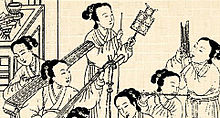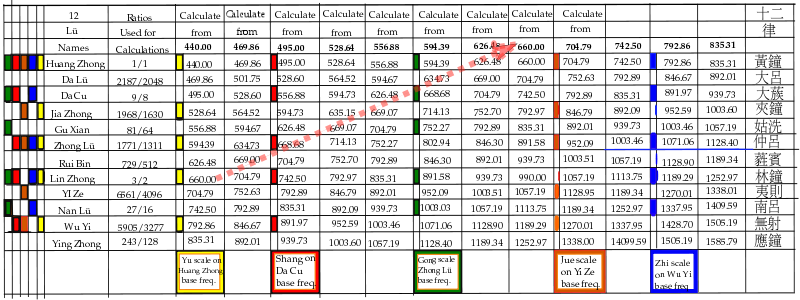- Chinese musicology
-
Music of China 
Timeline General topics Genres Specific forms Media and performance Music festivals Midi Modern Music Festival Music media National anthem Regional music Chinese musicology is the academic study of traditional Chinese music. This discipline has a very long history. The concept of music yue stands among the oldest categories of Chinese thought, however, in the known sources it does not receive more or less clear definition until the Book of Music (partly preserved as the Classic of music).
Contents
Music scales
Main article: GuqinThe first musical scales were derived from the harmonic series. On the Guqin all of the dotted positions are equal string length divisions related to the open string like 1/2, 1/3, 2/3, 1/4, 3/4, etc. and are quite easy to recognize on this instrument. The Guqin has a scale of 13 positions all representing a natural harmonic position related to the open string. All musical tunings all over the world are based on this primary system. Afterwards different cultures moved to alternate variations of this harmonic system.
Main article: Shi Er LüThe ancient Chinese defined, by mathematical means, a gamut or series of Shi Er Lü (called the 十二律 12 lü) from which various sets of five or seven frequencies were selected to make the sort of "do re mi" major scale familiar to those who have been formed with the Western Standard notation. The 12 lü approximate the frequencies known in the West as A, B flat.....G, and A flat.
 How the scales are produced. Start with a fundamental frequency. (440 hertz is used here.) Apply the ratios to make the first column. Copy the second and all further elements in this column to the respective heads of the other eleven columns. Apply the ratios to make the second through the twelfth columns. So doing produces 144 frequencies (with some duplications). From each column five different selections of non-adjacent frequencies can be made. (See the colored blocks at the far left.) So each column can produce 60 different pentatonic scales.
How the scales are produced. Start with a fundamental frequency. (440 hertz is used here.) Apply the ratios to make the first column. Copy the second and all further elements in this column to the respective heads of the other eleven columns. Apply the ratios to make the second through the twelfth columns. So doing produces 144 frequencies (with some duplications). From each column five different selections of non-adjacent frequencies can be made. (See the colored blocks at the far left.) So each column can produce 60 different pentatonic scales.
Scale and tonality
Most Chinese music uses a pentatonic scale, with the intervals (in terms of lǜ) almost the same as those of the major pentatonic scale. The notes of this scale are called gong, shang, jue, zhi, and yu. By starting from a different point of this sequence, a scale (named after its starting note) with a different interval sequence is created, similar to the construction of modes in modern Western music.
Since the Chinese system is not an equal tempered tuning, playing a melody starting from the lǜ nearest to A will not necessarily sound the same as playing the same melody starting from some other lǜ, since the wolf interval will occupy a different point in the scale. The effect of changing the starting point of a song can be rather like the effect of shifting from a major to a minor key in Western music. Pythagoras's scalar tunings, based on 2:3 ratios (8:9, 16:27, 64:81, etc.), are a western near-parallel to the earlier calculations used to derive Chinese scales.
Source
- 一种体系 两个系统 by 陈应时 (Yi zhong ti-xi, liang ge xi-tong by Chen Ying-shi of the Shanghai Conservatory), Musicology in China, 2002, Issue 4, 中国音乐学,2002,第四 期
External links
Categories:- Chinese music
- Philosophy of music
- Musicology
- Musical scales
- Chinese music stubs
Wikimedia Foundation. 2010.
